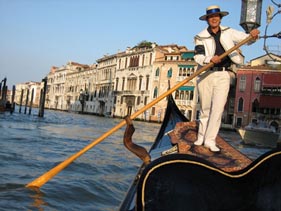Venice behind the mask

A tale of two islands behind a resurgence in Venice’s traditional crafts
Where do the locals eat? What sort of question is this in a city that is engulfed by tourists Every day of the year Venetians are outnumbered by tourists 4 to 1. This iconic world heritage city revitalized its economy using its massive cultural heritage to attract big-spending tourists as far back as Napoleon.
And what attracts tourists to Venice, bringing economic rewards, employment and opportunity?
Venice’s incredible heritage and unique nature – romantic, musical, stunningly beautiful, movingly delicate, refelected in its wonderful food and sights, astonishing artefacts – Murano glass, Burano lace, Venetian papier-mache carnival masks, fabulous clothes.
And an astonishing array of art and architecture, the heritage of one of the world’s great maritime powers, which brought great wealth, and a massive treasure trove of great art and great music to La Serenissima.
It’s what brings the tourists now – it’s not just the coffee in St Marks Square, the gondola ride, the walk under the Bridge of Sighs, the stunning Campanile, the Rialto Bridge. It’s the fact that great history took place at these places, the city’s depth of academic, artisan and mercantile heritage goes back almost 1,000 years.
It is, of course, important to preserve this heritage, not as a global museum, but as a living, breathing, working, singing city. Otherwise all of this practical understanding will die.
So, when the Opera House – La Fenice burnt down – on 29 January 1996, it was completely destroyed by fire. The call was to restore it exactly how it was.
But how? There weren’t the same artisans available in 1996 as in 1844 when it was rebuilt from a previous fire.
A typical Venetian response took place – luckily San Servolo island had been acquired by the European Centre for the Training for the Artisan of the Architectonic Property where students learn traditional artisan techniques for artistic restoration.

Now was the time to get this investment working properly to train and assist the reconstruction. After various delays, reconstruction began in earnest in 2001. In 650 days, a team of two hundred plasterers, artists, woodworkers, and other craftsman succeeded in recreating the ambience of the old theatre at a cost of some €90 million.
Success – La Fenice was rebuilt in 19th-century style on the basis of a design by architect Aldo Rossi and using still photographs from the opening scenes of Luchino Visconti’s 1954 film Senso, which was filmed in the house, in order to obtain details of its design. It reopened on 14 December 2003 with an inaugural concert of Beethoven, Wagner, and Stravinsky. The first opera production was La Traviata in November 2004.
Now Venice believes its maritime heritage and understanding is slipping too – so what’s the response?
An island of course! The Certosa Island is in the middle of the Venice lagoon, between the historic centre and the Lido inlet. Home to monks from the12th century, the island was latterly a munitions warehouse and factory in use until 1958, when it fell into disrepair.

The island’s rebirth as a global yachting and maritime centre was inspired by a team of young sailors who had a dream to create an international centre of excellence for maritime heritage. Vento de Venezia (Venetian Wind)
Not only is the island now a yachtsman’s paradise with a 300 berth marina and1600 sqm indoor yacht maintenance facility, but it also provides a home for traditional woodcraft yacht workshops, engineering workshops, sail loft, Italian, French and Royal Yacht Association sail schools, but also teaches all the traditional Venetian skills such as sculling.

And, of course, as befits Venice – there is a major European marina opening on to the Venice Lagoon Park.
The island project is conceived as sustainable development not only in its training aspirations but also in its concepts of energy use and development. For examples – water and electrical systems were designed using energy-saving sustainable technologies, rainwater is harvested for use in irrigation and fire-prevention, roofs are covered in photovoltaic film.
The project aims to deliver a floating marine swimming pool and a tethered hot air balloon – so it will also be a small, sustainable tourism hot-spot – hence the small 18 room friendly 3 star hotel Certosa already built.
And the big success so far? The Americas Cup 2012 will be held here! World-class maritime success beckons.
Valere Tjolle
Valere Tjolle
FREE and Special Offers on sustainable tourism information for destinations, tour operators, travel agents, hotels, tourist attractions, colleges and universities HERE
Special offer this week HERE
 United Kingdom
United Kingdom United States
United States Asia Pacific
Asia Pacific












































Dozens fall ill in P&O Cruises ship outbreak
Turkish Airlines flight in emergency landing after pilot dies
Boy falls to death on cruise ship
Unexpected wave rocks cruise ship
Woman dies after going overboard in English Channel